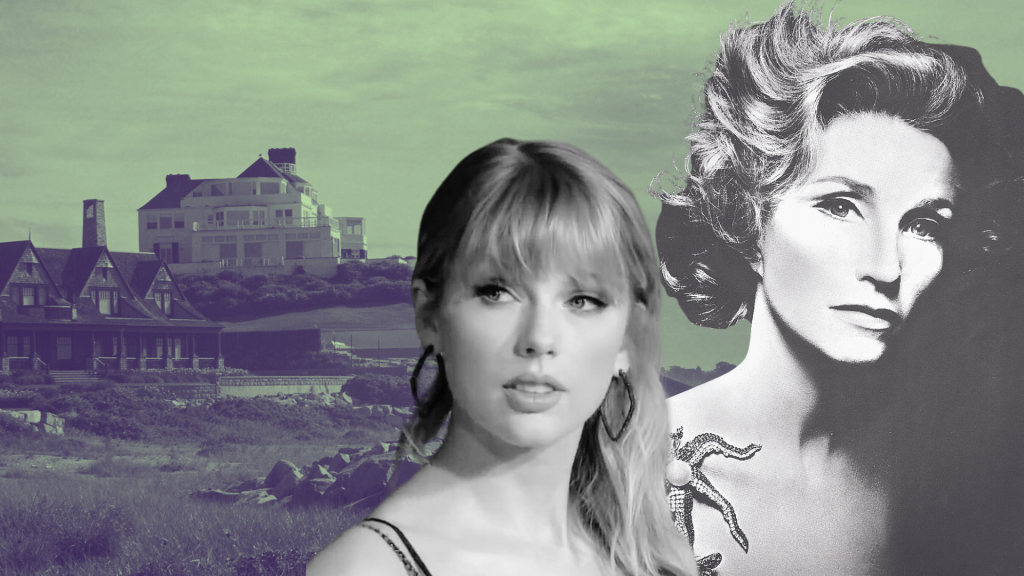
Wealth has a profound impact on an individual’s role and perception within society, providing a platform for influence, control, and legacy building. This dynamic is demonstrated through the lives of two Rhode Island celebrities, one modern day, one from decades past: Taylor Swift and Rebekah Harkness. These two women, whose considerable fortunes have shaped their societal roles in unique ways, are connected through Swift’s song “The Last Great American Dynasty,” which tells the story of Harkness and her extravagant life in the same Rhode Island mansion Swift later purchased.
TAYLOR SWIFT: A MODERN ICON
Taylor Swift, a globally renowned singer-songwriter, born on December 13, 1989, in West Reading, Pennsylvania, has amassed significant wealth through her successful music career. This financial success has enabled her to go beyond the role of a mere entertainer, becoming a powerful advocate and influencer in various social arenas.
Swift’s financial independence allows her to champion causes such as artist rights, gender equality, and LGBTQ+ issues. For instance, her public dispute with her former record label over the ownership of her master recordings brought to light critical issues regarding artists’ rights and control over their work. This battle not only highlighted Swift’s commitment to her principles but also sparked a broader conversation about the treatment of artists in the music industry.
In addition, Swift uses her wealth to engage in philanthropy, donating millions to disaster relief efforts, education, and cultural institutions. Her substantial charitable contributions enhance her public image, positioning her as a compassionate and responsible public figure. This dual role as both a successful artist and a benefactor allows her to wield considerable influence in shaping public discourse and societal norms.
REBEKAH HARKNESS: THE ECCENTRIC PATRON OF THE ARTS
Rebekah Harkness, an heiress to the Standard Oil fortune, was a prominent socialite and patron of the arts in the mid-20th century. Harkness was born into wealth on April 17, 1915, in St. Louis, Missouri. Her father, Allen Tarwater West was a successful St. Louis stockbroker.
Her wealth enabled her to significantly impact the cultural landscape, particularly through her support of ballet. Harkness established the Harkness Ballet and funded numerous artistic endeavors, leaving a lasting legacy in the arts.
Harkness’s fortune allowed her to play the traditional role of a wealthy contributor, but her approach was marked by extravagance and eccentricity. Her involvement in the artistic process sometimes led to conflicts, as her hands-on management style clashed with the creative visions of the artists she supported. This tension highlights the complexities of using wealth to influence creative fields, where financial support can be both a boon and a source of contention.
THE CONNECTION: “THE LAST GREAT AMERICAN DYNASTY”
Taylor Swift’s purchase of the Holiday House for $17.75 million in 2013, a grand Rhode Island mansion once owned by Rebekah Harkness, links these two influential women in history. Swift’s song “The Last Great American Dynasty” narrates the story of Harkness’s life, painting a picture of her as a misunderstood and maligned figure whose wealth both empowered and isolated her. Swift sings, “Who knows, if she never showed up, what could’ve been. There goes the most shameless woman this town has ever seen. She had a marvelous time ruining everything.”
Through the song, Swift draws parallels between herself and Harkness, exploring themes of wealth, societal judgment, and legacy. “Who knows, if I never showed up, what could have been. There goes the loudest woman this town has ever seen. I had a marvelous time ruining everything.” By telling Harkness’ story, Swift resurrects the memory of a fascinating and controversial figure, and reflects on her own experience with wealth and public perception.
COMPARING THEIR LEGACIES
Both Swift and Harkness illustrate how wealth can shape an individual’s societal role and legacy, albeit in different ways. Swift’s modern use of wealth focuses on advocacy and empowerment, leveraging her platform to effect social change and support fellow artists. In contrast, Harkness’ legacy as a patron of the arts was more traditional, and reflected the mid-20th century norms of wealthy individuals supporting cultural institutions.
Their societal contexts also differ significantly. Swift operates in a digital age where her actions and statements elicit immediate global responses — from praise to backlash, both amplified by social media. Harkness, in contrast, influenced a more localized sphere, her impact was primarily felt within elite circles and established cultural institutions.
Wealth undeniably influences an individual’s role and perception within society. For Swift, it provides a platform for advocacy and philanthropy, enhancing her influence and societal impact. For Harkness, wealth facilitated her role as a patron of the arts, though not without controversy and conflict. The connection between Swift and Harkness, highlighted in “The Last Great American Dynasty,” underscores the enduring impact of wealth on societal roles and legacies, revealing both the potential and the difficulty that come with great fortune.
Yaritza Arriaza Caceres is an intern at Motif from The Met School in Providence.